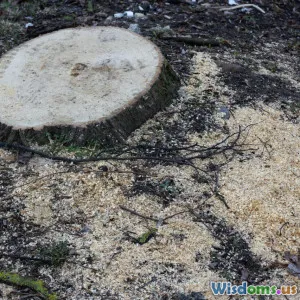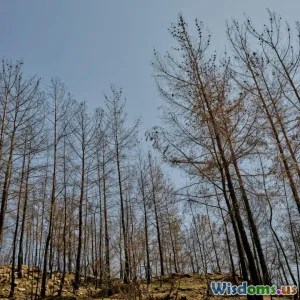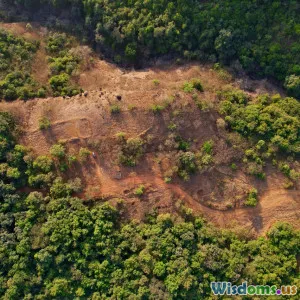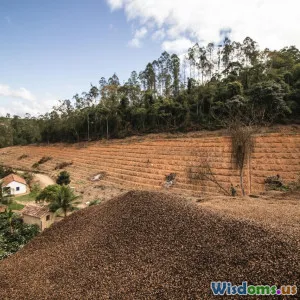
What Happens to Wildlife When Forests Disappear
9 min read Explore the profound effects of deforestation on wildlife, revealing the cascading ecological and behavioral impacts when forests vanish. (0 Reviews)
What Happens to Wildlife When Forests Disappear
The disappearance of forests is one of the most urgent environmental crises of our time. Forests cover about 31% of the Earth's land area and are home to more than 80% of the terrestrial species of animals, plants, and fungi. When these forests are cleared for agriculture, urban development, or logging, it isn’t just trees that suffer—the wildlife living within these ecosystems face existential threats. What really happens to wildlife when forests vanish? This article explores the multi-layered consequences of deforestation on animal species worldwide, offering real-world examples, scientific insights, and unveiling the ripple effects on biodiversity, ecology, and ultimately humanity itself.
1. The Foundation of Life: Forests as Crucial Habitat
Forests as Biodiversity Hotspots
Tropical rainforests like the Amazon, Congo, and Southeast Asian forests are biodiversity hotspots, containing an estimated 50% of all known terrestrial species within a relatively small area. Forests provide complex, layered habitats that support a diversity of wildlife—canopy layers offer niches for arboreal mammals and birds, understory plants serve insects and reptiles, and forest floors provide shelter and foraging grounds.
Habitat Loss and Fragmentation
When forests disappear, the most immediate impact on wildlife is the loss of habitat. Species that have evolved over millennia to thrive in these specialized environments suddenly find themselves displaced. For example, the deforestation rate in the Amazon basin increased from 7,000 square kilometers per year in the early 2000s to over 10,000 square kilometers by 2020, forcing animals like jaguars, the Amazon river dolphin, and countless bird species out of their homes.
Fragmentation—where continuous forest becomes divided into isolated patches—compounds the problem. Small, isolated populations become vulnerable to inbreeding, loss of genetic diversity, and increased predation. For instance, the northern spotted owl in North America has seen population declines directly linked to habitat fragmentation.
2. The Domino Effect: Ecological Consequences of Forest Loss on Wildlife
Food Chain Disruptions
Forests sustain a delicate balance of food webs. Deforestation disrupts this by eliminating crucial food sources. Herbivores lose access to leaves, fruits, and seeds, which in turn affects carnivores and omnivores higher up the chain. The decline of fig trees in cleared tropical forests is particularly significant as figs are a keystone species, providing year-round fruit for more than 1200 animal species.
Altered Microclimates
Trees regulate forest microclimates by providing shade, moderating temperatures, and retaining soil moisture. Removing forests can increase local temperatures and dryness, which impacts amphibians and other moisture-dependent species severely. The golden poison dart frog of Colombia, for instance, requires the humid microclimate of dense rainforest to survive.
Increased Predation and Human-Wildlife Conflicts
With fewer hiding places and reduced habitat, prey animals become more exposed to predators. Additionally, as forests vanish, wildlife moves closer to human settlements, leading to conflicts. Elephants raiding crops in deforested areas, or leopards venturing into villages, demonstrate these dangerous encounters.
3. Species Extinction: The Grim Toll of Deforestation
Deforestation is among the most significant drivers of species extinction worldwide. The International Union for Conservation of Nature (IUCN) estimates that habitat loss threatens more than 85% of all species listed as endangered.
Case Studies in Extinction Risks
-
Sumatran Orangutan: With over 80% of its habitat lost to logging and palm oil plantations, the Sumatran orangutan population declined by more than 75% over 50 years. They depend on the forest canopy for food and movement; loss forces them into smaller groups, affecting social structures and reproduction.
-
Borneo’s Pygmy Elephant: Habitat loss has confined this subspecies to fragmented forest patches, making inbreeding and genetic bottlenecks urgent concerns.
-
Vaquita Porpoise: While not a forest dweller, this species illustrates how habitat degradation (in this case aquatic ecosystems impacted by deforestation-driven sediment runoff) causes marine wildlife decline.
4. Behavioral Changes and Adaptations in Wildlife
While many species decline, some demonstrate remarkable resilience and adaptability.
Shift in Diet and Movement Patterns
Generalist species like raccoons or crows adjust their diet to urban waste and altered environments. Mountain lions in California have been observed traveling longer distances through fragmented habitats to find mates or prey.
Increased Stress and Reproductive Issues
Stress caused by habitat disturbance is linked to elevated cortisol levels in species such as birds and primates, impacting fertility and survival rates. A study on red colobus monkeys showed decreased birth rates correlating with heavy logging activity in Ugandan forests.
Novel Habitats and Urban Wildlife
Some species adapt by inhabiting secondary forests, plantations, or even cities. The adaptability of certain species offers hope but does not compensate for the loss of specialized species unable to survive outside old-growth forests.
5. Cascading Effects on Ecosystem Services and Human Communities
Wildlife is integral to ecosystem services—pollination, seed dispersal, and pest control—for the health of forests and humans alike. Loss of wildlife disrupts seed dispersal, slowing forest regeneration and altering plant communities. For example, large seed-dispersing birds like hornbills play critical roles in tropical forest maintenance; their decline has measurable effects on tree diversity.
Human communities relying on forests for food, medicine, and cultural identity also suffer, creating a feedback loop that pressures_remaining forest areas further.
6. What Can Be Done? Conservation and Restoration Efforts
Protecting Remaining Forests
Legal protections, indigenous land rights recognition, and enforcement against illegal logging help safeguard remaining forests. The Amazon Soy Moratorium, an agreement to prevent soy cultivation on deforested lands, exemplifies effective multi-stakeholder interventions.
Habitat Restoration
Reforestation and afforestation projects aim to restore habitats. Notably, Costa Rica has successfully incentivized forest regrowth through payments to landowners.
Wildlife Corridors
Creating corridors linking fragmented forests enables animal movement, gene flow, and species survival. Thailand’s Elephant corridors offer an example of implemented conservation efforts.
Citizen Science and Education
Educating the public on deforestation’s impacts encourages sustainable consumption choices, such as reducing demand for products linked to forest loss.
Conclusion
The disappearance of forests spells dire consequences for wildlife, unraveling intricate ecological networks built over millions of years. Habitat loss, behavioral shifts, and increased extinction risks paint a sobering picture. Yet, through informed policies, community engagement, and conservation innovation, the tide can still turn. Protecting and restoring forests not only preserves wildlife but underpins the health of our planet and the future of humanity. The question is clear: will we act decisively before the silence of vanished forests becomes our legacy?
Rate the Post
User Reviews
Popular Posts

















